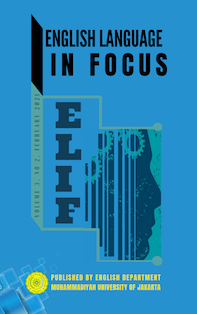English Speaking Anxiety in Language Learning Classroom
DOI:
https://doi.org/10.24853/elif.3.2.99-108Keywords:
speaking skill, anxiety, problem, psychological, linguisticAbstract
English as a foreign language consists of four skills namely, listening, speaking, reading, and writing. These skills have a particular issue that happens differently for each student. For this reason, it's not easy to understand and master the four language skills effectively. Several issues need to overcome first to increase the effectiveness of each ability. Speaking is one of the skills that seem to represent the students' proficiency to speak English. Unfortunately, the majority of Indonesian students, in particular those at the university level, do not provide an appropriate way to speak English proficiently. Students in the 4.0 era are expected to have good communication skills and the ability to socialize with their community. Speaking also requires practice and a deep psychological pleasure that needs to be comfortable. A related study that improves the effectiveness of speaking in language teaching and learning is important. This study is a descriptive study that explains the importance of effective communication in English as a foreign language. This study also provides an opportunity to measure the effectiveness of teaching and learning English speaking skills earlier in the process, which can increase students' confidence and decrease students' anxiety in speaking skills.References
Al Hosni, S. (2014). Speaking Difficulties Encountered by Young EFL Learners. International Journal on Studies in English Language and Literature (IJSELL), 2(6), 22–30. http://www.arcjournals.org/
Al Nakhalah, A. M. M. (2016). Problems and Difficulties of Speaking That Encounter English Language Students at Al Quds Open University. International Journal of Humanities and Social Science Invention, 5(12), 96–101. http://www.ijhssi.org/
Ali, M. A. K. (2017). International Journal of Psychology and Educational Studies English Language Anxiety: Development and Validation of a Brief Measure. International Journal of Psychology and Educational Studies, 4(2), 42–53. https://doi.org/10.17220/ijpes.2017.02.005
Correa, D., & González, A. (2016). English in Public Primary Schools in Colombia: Achievements and Challenges Brought About by National Language Education Policies. Education Policy Analysis Archives, 24(83), 1–30. https://doi.org/10.14507/epaa.24.2459
Elliott, R., Fischer, C. T., & Rennie, D. L. (1999). Evolving Guidelines for Publication of Qualitative Research Studies in Psychology and Related Fields. British Journal of Clinical Psychology, 38(3), 215–229. https://doi.org/10.1348/014466599162782
Hadi, M. S., Izzah, L., & Masae, M. (2020). Factors Affecting Speaking Anxiety of Thai Students During Oral Presentation: Faculty of Education in TSAI. English Language in Focus (ELIF), 3(1), 79–88. https://doi.org/10.24853/elif.3.1.79-88
Hiebert, E. H., & Kamil, M. L. (2005). Teaching and Learning Vocabulary : Bringing Research to Practice. In The Teaching and Learning of Vocabulary Marwah, NJ. Lawrence Erlbaum Associates. https://doi.org/10.4324/9781410612922
Hinkel, E. (2005). Handbook of Research in Second Language Teaching and Learning. In Handbook of Research in Second Language Teaching and Learning. Routledge. https://doi.org/10.4324/9781410612700
Horowitz, R., & Samuels, S. J. (1987). Comprehending Oral and Written Language. San Diego: Academic Press.
Horwitz, E. K., Horwitz, M. B., & Cope, J. (1986). Foreign Language Classroom Anxiety. The Modern Language Journal, 70(2), 125–132. https://doi.org/10.1111/j.1540-4781.1986.tb05256.x
Nufus, T. Z. (2018). Teaching English to Young Learners in Indonesia (Pros and Cons). English Language in Focus (ELIF), 1(1), 65-70. https://doi.org/10.24853/elif.1.1.65-70
Ounis, A. (2017). The Assessment of Speaking Skills at the Tertiary Level. International Journal of English Linguistics, 7(4), 95–112. https://doi.org/10.5539/ijel.v7n4p95
Rabab’ah, G. (2003). Communication Problems Facing Arab Learners of English. Language Learning Journal, 3(1), 180–197.
Ramdani, A. S. (2019). The Use of Voki as A Media to Support the Enhancement of First Grade Students Speaking Skills at SMPN 4 Tambun Selatan. Jurnal Inovasi Pendidikan MH Thamrin, 2(1), 12–25. https://doi.org/10.37012/jipmht.v2i1.32
Richards, J. C. (2008). Teaching Listening and Speaking: From Theory to Practice. Cambridge: Cambridge University Press.
Richards, Jack C, & Renandya, W. A. (2002). Methodology in Language Teaching. In Methodology in Language Teaching. Cambridge: Cambridge University Press. https://doi.org/10.1017/cbo9780511667190
Savignon, S. J. (1987). Communicative Language Teaching. Theory Into Practice, 26(4), 235–242. https://doi.org/10.1080/00405848709543281
Sekhar, G. R., & Chakravorty, S. (2017). TESL/TEFL: Teaching English as a Second or Foreign Language. ACADEMICIA: An International Multidisciplinary Research Journal, 7(4), 154.
https://doi.org/10.5958/2249-7137.2017.00044.1
Syahrozi, H., Rochsantiningsih, D., & Handayani, E. I. P. (2018). Improving Students’ Motivation in Learning English Using Movie Clip. English Education, 7(1), 55–63. https://doi.org/10.20961/eed.v7i1.35835
Thompson, C. J., & Millington, N. T. (2012). Task-Based Learning for Communication and Grammar Use1. Language Education in Asia, 3(2), 159–167. https://doi.org/10.5746/LEiA/12/V3/I2/A04/Thompson_Millington
Ur, P. (1999). A Course in Language Teaching Trainee Book. In A Course in Language Teaching Trainee Book. https://doi.org/10.1017/cbo9780511732928
Utami, A. R., Yulianto, B., & Agustina, R. K. (2020). Fostering Students’ Speaking Ability through Traditional Talking Stick. English Language in Focus (ELIF), 2(2), 71-78. https://doi.org/10.24853/elif.2.2.71-78
Winstanley, M., Webb, R. T., & Conti-Ramsden, G. (2018). More or Less Likely to Offend? Young Adults with a History of Identified Developmental Language Disorders. International Journal of Language and Communication Disorders, 53(2), 256–270. https://doi.org/10.1111/1460-6984.12339
Young, D. J. (1990). An Investigation of Students’ Perspectives on Anxiety and Speaking. Foreign Language Annals, 23(6), 539–553. https://doi.org/10.1111/j.1944-9720.1990.tb00424.x
Zhang, F., & Yin, P. (2009). A Study of Pronunciation Problems of English Learners in China. Asian Social Science, 5(6), 141–146. https://doi.org/10.5539/ass.v5n6p141
Zhang, H., & Alex, N. K. (1995). Oral Language Development across the Curriculum, K-12. http://www.eric.ed.gov/
Downloads
Published
Issue
Section
License
Authors who publish with this journal agree to the following terms:
- Authors retain copyright and grant the journal right of first publication with the work simultaneously licensed under a Creative Commons Attribution License that allows others to share the work with an acknowledgment of the work's authorship and initial publication in this journal.
- Authors can enter into separate, additional contractual arrangements for the non-exclusive distribution of the journal's published version of the work (e.g., post it to an institutional repository or publish it in a book), with an acknowledgment of its initial publication in this journal.
- Authors are permitted and encouraged to post their work online (e.g., in institutional repositories or on their website) before and during the submission process, as it can lead to productive exchanges, as well as earlier and greater citation of published work (See The Effect of Open Access).


